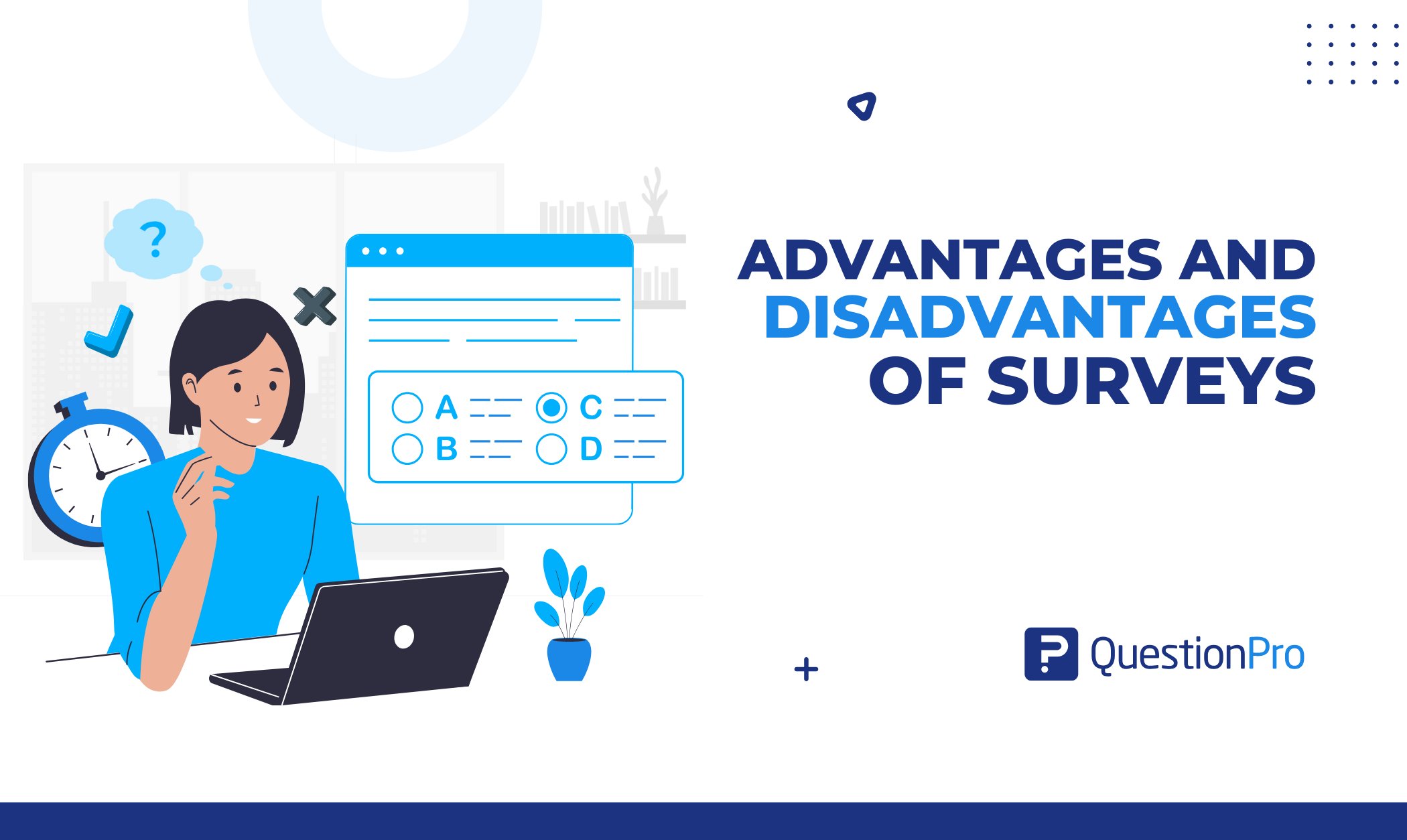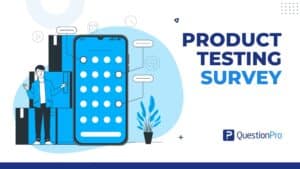
Surveys are one of the most popular research methods worldwide. They offer clear advantages, like scalability and cost efficiency, but also disadvantages, such as sampling bias and survey fatigue. Understanding the advantages and disadvantages of surveys is key to making surveys work effectively.
Whether you’re conducting market research, analyzing customer feedback, or running an academic study, knowing the pros and cons of surveys will help you make better decisions and improve the quality of your results.
In this blog, we’ll explore the advantages and disadvantages of surveys, with clear examples to help you understand when and how to use them effectively.
What is a Survey?
A survey is a method of collecting information from a group of people by asking structured questions. You can distribute surveys through email, social media, QR codes, text messages, or web links, making them quick, scalable, and easy to access.
The primary goal of a survey is to gather reliable and actionable data that helps researchers, marketers, and decision-makers make informed choices. By understanding trends, preferences, or pain points, surveys provide the insights needed to guide strategy and improve products, services, or processes.
To ensure accurate and meaningful results, surveys should use clear, unbiased questions and a well-structured questionnaire. They are highly flexible in format and can include a variety of question types, such as:
- Rating scales: Measure opinions or satisfaction numerically.
- Multiple-choice questions: Gather structured, easily analyzable responses.
- Open-ended questions: Capture detailed feedback, opinions, or suggestions.
By combining these elements, surveys provide a powerful and adaptable way of collecting both quantitative and qualitative insights from your target audience.
Advantages of Surveys: Why They Are Essential for Data Collection
Surveys are one of the most versatile and widely used tools for data collection in both business and research contexts. They provide a structured way to gather opinions, feedback, and insights from a large group of participants efficiently.
From reaching a global audience to delivering actionable insights, surveys offer numerous benefits that make them indispensable for organizations of all sizes.
Whether you’re conducting market research, measuring customer satisfaction, or evaluating employee engagement, understanding the advantages of surveys can help you design better studies, collect high-quality data, and make informed decisions that drive results.
1. Reach a Large Audience Quickly
One of the biggest advantages of surveys is their ability to reach a large audience efficiently. With online surveys, you can:
- Send your questionnaire via email
- Share it on social media platforms
- Use web links to reach participants anywhere in the world
A larger sample gives you more reliable results and lets you draw conclusions that truly reflect your audience.
For example, A global e-commerce company can send a survey to 12,000 customers across four continents and collect feedback in under a week.
2. Cost-Effective Data Collection
One of the biggest advantages of surveys is how budget-friendly they are compared to other research methods. Unlike focus groups or one-on-one interviews, surveys allow you to collect meaningful data without spending a fortune.
You don’t need to pay for:
- Travel or accommodation for participants or researchers
- Printing questionnaires or materials
- Hiring facilitators, interviewers, or moderators
- Renting venues for in-person sessions
- Additional staff to manage logistics
Because of this, surveys are perfect if you’re working with a limited budget or want to get the most out of your research spend. They allow you to reach a wide audience without scaling costs dramatically.
In addition, online survey platforms let you save time and money while still maintaining high-quality data. You can:
- Distribute surveys instantly via email, social media, or web links
- Collect responses from a global audience without added expense
- Use pre-built templates to reduce design and setup time
- Automate data collection and analysis for faster insights
For example, a researcher can mail a 7-page questionnaire to 500 participants across Maine for just over $1,000. Conducting in-person interviews for the same study would have cost several times more. Online survey tools can achieve the same results for a fraction of the cost, while providing even faster and more actionable insights.
3. Standardized & Quantifiable Results
Surveys provide consistent and measurable data because every respondent answers the same set of questions in the same format. This consistency ensures that your results are reliable and comparable across different groups, making it easier to analyze patterns and trends.
Structured questions, such as multiple-choice or rating scales, allow you to quantify responses and quickly generate insights. You can calculate averages, percentages, and trends, and use charts or reports to visualize the data effectively.
For example, an educational institution can conduct a course evaluation across all departments using a single, unified survey. This approach makes it possible to fairly compare student satisfaction scores and identify areas for improvement.
By providing standardized and quantifiable results, surveys give you clear, actionable data that can guide decisions, track performance, and improve outcomes over time.
4. Flexibility in Design
Surveys stand out because they let you customize the design to fit your research needs. You’re not limited to one type of question or flow, which gives you the freedom to collect both quantitative and qualitative insights.
You can include:
- Multiple-choice questions for quick, clear responses
- Rating scales to measure opinions and satisfaction
- Open text boxes for detailed, descriptive feedback
- Branding elements to match your company or project
- Skip logic and conditional flows to guide respondents through relevant questions
For example, a SaaS company can create a branded NPS survey that adjusts dynamically based on whether a user gives a high or low rating. They can also add their company logo, change themes to match their brand identity, and include a custom thank-you page at the end of the survey. This approach ensures follow-up questions are relevant to each participant’s experience while reinforcing brand consistency and leaving a positive impression.
By using a flexible survey design, you can ensure your questionnaires are engaging, visually appealing, and capable of delivering the precise insights you need to make informed decisions.
5. Anonymity Encourages Honest Feedback
One of the major strengths of surveys is that they can provide respondents with anonymity. When participants know their answers are confidential, they feel safer sharing their true opinions and experiences, which leads to more accurate and honest data.
Anonymous surveys can help you:
- Reduce bias
- Encourage honesty
- Capture sensitive feedback
- Increase responses
By providing anonymity, surveys become a reliable tool for collecting candid insights, helping you understand the true sentiments of your audience and make data-driven decisions that genuinely address their needs.
For instance, a company can run an anonymous employee engagement survey, allowing staff to share honest opinions about management, workplace culture, or internal processes without fear of repercussions. Respondents can confidently give feedback, which enables the organization to identify real issues, make improvements, and foster a more positive work environment.
6. Scalable Across Different Research Needs
Surveys are highly scalable, which makes them ideal for research projects of any size. Whether you’re collecting feedback from a small pilot group or reaching tens of thousands of respondents worldwide, surveys let you expand your research without significantly increasing costs or effort.
This flexibility ensures that your data remains consistent and reliable, no matter the scale of your study. It also maintains accuracy, efficiency, and actionable results. This makes surveys a powerful tool for businesses, researchers, and organizations looking to gather insights across different populations and research needs.
For example, a government agency can send a public opinion survey to thousands of residents via email and social media. They can manage responses efficiently, analyze data in real-time, and adjust the survey as needed, all without incurring major additional costs.
Disadvantages of Surveys: Challenges and Limitations You Should Know
While surveys are powerful tools for research, they are not without limitations. Understanding the disadvantages of surveys can help you design better studies, mitigate risks, and ensure the data you collect is accurate, reliable, and actionable.
Understanding both the advantages and disadvantages of surveys allows you to make smarter choices, whether you’re gathering feedback from customers, employees, or other audiences.
1. Risk of Low Response Rates
One common challenge with surveys is that they may receive low response rates. If too few participants complete your survey, the data may not accurately reflect your target audience. Factors like long surveys, lack of incentives, or poor timing can reduce participation.
To improve response rates, you can:
- Keep surveys short and focused
- Offer incentives for completion
- Send reminders to participants
For example, a government health agency can run an online survey, but if outreach is limited or the survey is long, many participants may not respond, resulting in incomplete data.
2. Limited Depth of Insight
Surveys are excellent for collecting quantitative data, but they may not capture deep qualitative insights. Without an interviewer, it’s challenging to explore complex opinions or probe for explanations.
For instance, a UX researcher can ask users what they like least about a product, but without follow-up, answers might remain vague or surface-level.
Limited depth means surveys may not reveal the full context behind participant behavior, so combining them with interviews or focus groups can provide a complete picture.
3. Survey Fatigue
Long or repetitive surveys can cause participants to lose interest, skip questions, or abandon the survey entirely. This “survey fatigue” can result in incomplete or low-quality responses, reducing the usefulness of your data.
Survey fatigue can compromise data quality, so keeping surveys concise and engaging is key to maintaining participant attention.
4. Potential for Bias
Surveys can introduce bias in several ways. It includes everything from question wording to respondents’ personal experiences. Even small phrasing issues can influence answers, which can lead to inaccurate or skewed data.
Common types of bias include:
- Social desirability bias: Where respondents answer in a way they think is expected.
- Sampling bias: When certain groups are underrepresented
- Response bias: Where emotions or recent experiences shape answers
For instance, employees can rate their manager highly on a workplace survey because they fear their responses are not truly anonymous.
Bias can affect the reliability of your findings, so careful survey design, pre-testing, and anonymity measures are critical to minimize errors.
5. Data Quality Concerns
Even when participants respond, surveys may still produce data quality issues. Misunderstood questions, skipped items, or inconsistent answers can reduce accuracy.
For example, a climate policy survey can ask, “Do you support renewable energy?” but respondents may interpret “support” differently. To solve this, the survey can provide a clear explanation of what “support” means, use multiple-choice options for clarification, or include follow-up questions to capture nuances.
Ensuring clear, unambiguous questions and monitoring data collection closely can help improve the quality of survey results.
6. Over-Reliance on Self-Reported Data
Surveys rely on participants to provide information about their own behaviors, opinions, or experiences. This can sometimes lead to inaccurate or biased data, as respondents may unintentionally misremember details or provide socially desirable answers instead of their true opinions.
To minimize this risk, you can:
- Cross-check survey responses with other data sources when possible.
- Use indirect or behavioral questions to validate self-reported information.
- Design questions that are clear, specific, and measurable to reduce ambiguity.
For example, a company can combine a customer satisfaction survey with actual usage data from their app or website. This allows them to compare self-reported experiences with real behavior, providing a more accurate and reliable view of customer satisfaction.
Best Practices to Maximize the Advantages and Reduce the Disadvantages
Conducting surveys effectively requires more than just sending out questions. To get the most accurate, actionable, and reliable insights, it’s essential to follow best practices that amplify the benefits of surveys while minimizing their limitations.
By implementing these strategies, you can ensure high-quality data, better engagement, and meaningful results. Here are the key best practices:
- Keep Surveys Short and Focused: Limit your questions to the essentials. Shorter surveys reduce fatigue, improve response rates, and encourage thoughtful answers.
- Use Clear, Simple Language: Avoid confusing or ambiguous wording. When participants understand questions consistently, your data becomes more accurate and reliable.
- Offer Anonymity: Protect respondent privacy to encourage honest, candid feedback, especially on sensitive topics.
- Test Surveys Before Launch: Run a small pilot to catch confusing questions, design issues, or technical glitches before sharing with a larger audience.
- Leverage Advanced Survey Tools: Use skip logic, conditional flows, branding, real-time dashboards, and AI-powered analytics to make surveys more engaging and insightful.
- Provide Incentives and Reminders: Increase participation by offering rewards or sending polite follow-ups to boost response rates.
- Combine Surveys with Other Research Methods: Pair surveys with interviews, focus groups, or observational research to gain deeper insights and context.
Advantages of Using the QuestionPro Survey Platform
While surveys have many benefits, using a professional platform like QuestionPro unlocks even more capabilities, helping you manage the entire research process efficiently and effectively.

- Different Question Types: You can use 35+ advanced question types, including rating scales, Net Promoter Score (NPS), multimedia questions, and advanced matrix tables to gather both quantitative and qualitative insights easily.
- Advanced Logic and Personalization: Add skip logic, display conditions, and piping to make your surveys dynamic and keep them relevant for each participant.
- Real-Time Dashboards and Reports: You can track responses instantly, generate charts and trends, and get actionable insights faster than ever with real-time dashboards and reports.
- AI-Powered Survey Creation and Features: Use the AI survey maker and built-in AI for sentiment analysis, open-ended responses, and survey design improvements to boost engagement and completion rates.
- Ready-to-Use Survey Templates: Start quickly with survey templates for NPS, customer satisfaction, employee engagement, or event feedback—all following best practices in survey design.
Conclusion
Surveys are a versatile and powerful tool for both business and market research. They help you collect actionable insights efficiently, offering advantages like cost-effectiveness, scalability, and fast data collection. At the same time, it’s important to be aware of potential challenges, such as sampling bias, survey fatigue, and misinterpretation of questions. Understanding the advantages and disadvantages of surveys can help you design better surveys.
Using online survey platforms like QuestionPro can help you overcome these challenges. Whether you’re a beginner or an experienced researcher, QuestionPro provides advanced logic, AI-powered tools, pre-built templates, and real-time analytics to make survey creation and data collection smarter and more reliable.
With these features, you can design engaging surveys, reach the right audience, and turn responses into meaningful insights that drive informed decisions and better outcomes for your organization.
Frequently Asked Questions (FAQs)
Answer: Online surveys are faster to distribute, easier to manage, and significantly more cost-effective than in-person or telephone methods, especially when targeting large or global audiences.
Answer: Use clear, unbiased questions, personalize the flow using skip logic, keep it short to avoid fatigue, and offer anonymity to encourage honest feedback.
Answer: Avoid vague or leading questions, overly long formats, poor question flow, and failing to test the survey on a small group before launch.
Answer: Yes. Surveys are highly adaptable and can be tailored to gather insights from customers, employees, students, or any other group relevant to your goals.
Answer: No. QuestionPro is designed to be user-friendly, with drag-and-drop tools, templates, and AI-powered features that simplify survey creation and analysis for all skill levels.
Answer: Surveys can gather both quantitative data (like ratings and rankings) and qualitative insights (like open-ended feedback and emotional responses).







